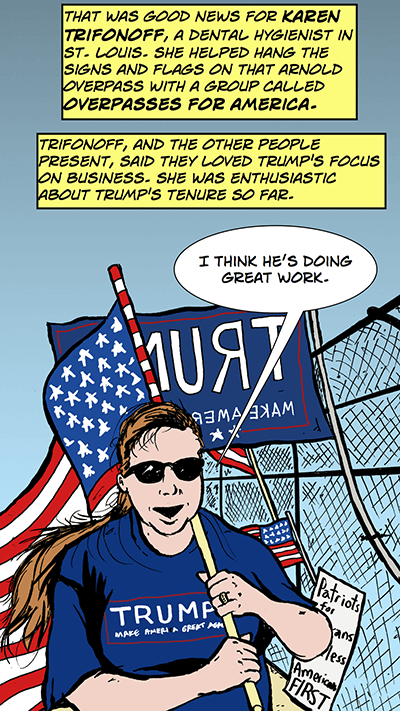DEAR READER: Why does this Trump article look like a comic book?

Originally published in the Columbia Missourian
So why was it drawn as a comic?
Having a reporter illustrate the news is actually an old idea. Back in the 19th century, war correspondents like Melton Prior both wrote and drew their reporting, for popular outlets such as The Illustrated London News.
They did this after the invention of photography. There was something illustration offered that couldn’t be found in other media.
Fast forward to the 1990s. Art Spiegelman’s graphic novel “Maus,” about his parents’ experience in the Holocaust, launched nonfiction comics into the mainstream. “Maus” won a Pulitzer Prize in 1992 under the “special citations” category, as if the committee wanted to say: “This is spectacular, but we have no idea how to categorize it.”
Now, it’s no longer strange for news organizations to use illustration in their reporting. You can read comics about Palestinian unrest in The New York Times, childhood poverty at Cincinnati, Ohio’s WCPO, narco-terrorism at ProPublica, post-Katrina New Orleans in The New Yorker … the list goes on.
It’s definitely attention-grabbing. But there are also deeper reasons to draw the news.
The comics theorist Scott McCloud thinks readers actually project themselves onto comic book characters. The more simply drawn the image, he wrote, the more we fill in the missing details with ourselves. If he’s right, that’s an extraordinary way to help readers empathize with others.
Another writer and critic, W.J.T. Mitchell, argued that visual media (like drawings or paintings) should still be considered multimedia, because the artist’s touch is a part of the piece.
“Seeing painting is seeing touching” he wrote, “seeing the hand gestures of the artist.”
Research has shown that using multiple senses, such as sight and touch, to understand something helps with comprehension. Drawings might make it easier to get our heads around complex topics.
Finally, the great comics artist Will Eisner wrote extensively about how comics is a participatory medium. At the beginning of “100 Days in Trump’s Missouri,” can you hear those truck “honks” in your head? Can you feel the wind blowing Karen Trifonoff’s hair? I think you can.
You’re also in charge of how fast the story moves. I made sure the Capitol building Cecilia Johnson approaches at the end of the comic was as detailed as possible, so that you could linger as long as you wanted in Jefferson City.
Many of these ideas remain theories. We definitely need more research on how viewers respond to comics, especially comics journalism.
In the meantime, it’s important that readers know how something like this comes together.
I based drawings of Trifonoff and Aaron Hedlund, the assistant economics professor at MU, on photographs I took during our interviews. Pastor Brian Letsinger and I only communicated by phone and email, so I drew him as he preached the Sunday before the election, based on a video from his church’s website. (You can watch it here.) You’ll notice that while I put his words in a word bubble, I did not extend the bubble to his mouth. It’s a quote, but not a quote from that pulpit.
The drawings of Cecilia Johnson were an amalgam of a few things. I had seen her testify at a hearing in Jefferson City before, though my reference photos from that day were not detailed. Because I was only illustrating her at the Capitol on a generic day, I based her outfit on a photograph she posted online, from being sworn in as president of the Kansas City Young Republicans.
Small changes were made for clarity. On that overpass in Arnold, for example, several buildings are visible through the chain-link fencing Trifonoff was standing next to. I decided not to draw them so as not to distract from her. My photos of the semi-trucks passing beneath her were also grainy, so I checked images of trucks online in order to capture small details on the vehicles that gave me hearing loss.
But other details, from the words on Hedlund’s chalkboard, to the design of Johnson’s necklace, are as they appeared in real life.
Journalism is journalism. While aesthetics may change, the ethics do not.